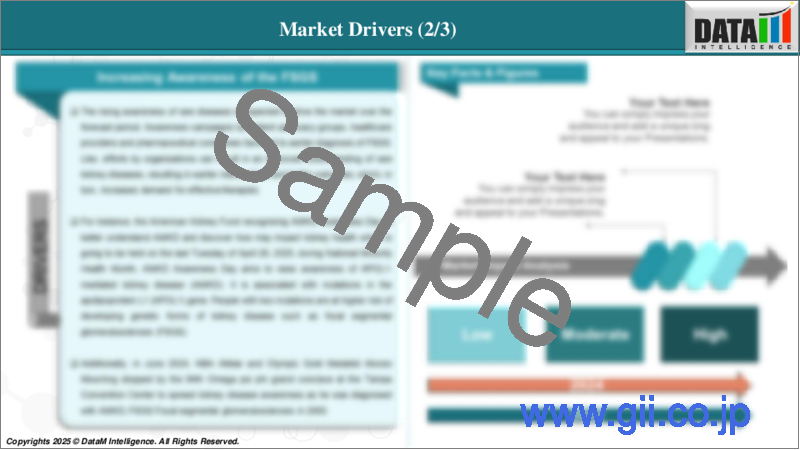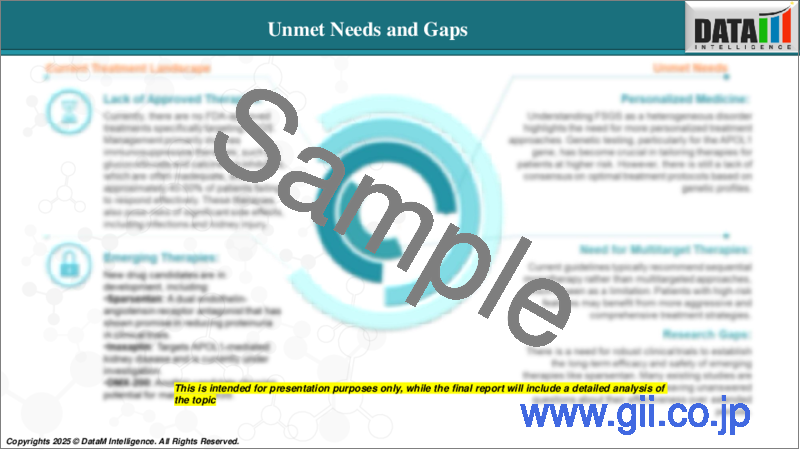|
|
市場調査レポート
商品コード
1678797
日本の遠隔医療市場 (2025年~2033年)Japan Telemedicine Market - 2025-2033 |
||||||
カスタマイズ可能
適宜更新あり
|
|||||||
| 日本の遠隔医療市場 (2025年~2033年) |
|
出版日: 2025年03月11日
発行: DataM Intelligence
ページ情報: 英文 140 Pages
納期: 即日から翌営業日
|
- 全表示
- 概要
- 目次
日本の遠隔医療(テレメディスン)市場は、2024年に51億4,291万米ドルに達し、2033年には258億6,749万米ドルに達すると予測され、予測期間2025年のCAGRは19.5%で成長します。
遠隔医療は、通信技術を利用して患者に医療上のアドバイスや診断、治療計画を提供する遠隔での医療提供方法です。地理的な距離、時間的制約、患者の移動の問題など、医療へのアクセスを阻む障壁に対処します。遠隔医療は、医療の人材が不足している地方では特に有益です。技術の進歩に伴い、遠隔医療には遠隔モニタリング、AI主導の診断、モバイルヘルス専門分野などのツールが組み込まれ、デジタル医療革命の重要な一翼を担っています。
市場力学:
促進要因と抑制要因
日本における高齢化と遠隔医療需要の高まり
日本の遠隔医療市場は、高齢化と遠隔医療需要の高まりによって牽引されています。65歳以上の高齢者がかなりの割合を占める日本は、糖尿病、高血圧、心血管疾患などの慢性疾患の発症率が高いです。遠隔医療は、特に遠隔地の高齢者に便利なソリューションを提供します。遠隔診察とモニタリング・システムは、患者と医療提供者の間のギャップを埋め、タイムリーなケアを保証し、病院への通院を減らします。このような遠隔医療への依存の高まりが、日本の市場成長の原動力となっています。
例えば、日本の入院医療需要は2040年までにピークに達すると予想され、2035-2040年には医療・福祉従事者が最大の産業となります。2040年の医療支出は89兆円に達し、2023年の1.6倍になると予測され、27兆円の財政不足を引き起こします。現在の医療水準を維持するためには、政府は価値の低い医療を削減し、医師から他の職種に業務をシフトし、デジタルトランスフォーメーションによって効率を向上させる必要があるかもしれません。
規制上の課題とデータ・プライバシーへの懸念
日本の遠隔医療市場は、厳格な医療規制による規制上の課題とデータ・プライバシーの懸念に直面しています。遠隔医療は医療へのアクセスを向上させますが、こうした規制がデジタルヘルス・ソリューションの普及を制限しています。遠隔医療プラットフォームは、患者の守秘義務、データ・セキュリティ、ライセンシングの要件を遵守しなければなりません。特にサイバーセキュリティの脅威が高まる中、個人健康データの安全な伝送と保存の確保は大きな懸念事項です。このような複雑な規制状況は、日本における遠隔医療サービスの成長を鈍らせる可能性があります。
目次
第1章 分析手法と分析範囲
第2章 定義と概要
第3章 エグゼクティブサマリー
第4章 市場力学
- 影響要因
- 促進要因
- 日本における人口の高齢化と遠隔医療の需要増大
- 抑制要因
- 規制上の課題とデータプライバシーに関する懸念
- 機会
- 影響分析
- 促進要因
第5章 産業分析
- ポーターのファイブフォース分析
- サプライチェーン分析
- 価格分析
- 規制分析
第6章 種類別
- mヘルス
- 遠隔病院/診療所
- 遠隔自宅医療
第7章 専門分野別
- 皮膚科
- 心臓病学
- 婦人科
- 精神医学
- 外傷治療
- その他
第8章 エンドユーザー別
- 病院
- クリニック
- その他
第9章 競合情勢
- 競合シナリオ
- 市況・シェア分析
- M&A分析
第10章 企業プロファイル
- Nihon Kohden Corporation
- 企業概要
- 製品ポートフォリオ
- 製品説明
- 製品の主要業績評価指標(KPI)
- 製品販売の実績・予測
- 製品販売量
- 財務概要
- 企業の収益
- 収益シェア:地域別
- 収益予測
- 主な動向
- 企業合併・買収 (M&A)
- 主な製品開発活動
- 規制当局の承認等
- SWOT分析
- MEDLEY, INC
- Terumo Corporation
- M3, Inc
- Medmain
- PK Telehealth
- NTT Data Inc
- Sony Corporation
- 同様のデータが各企業について提供されます。
第11章 付録
The Japan Telemedicine market reached US$ 5,142.91 million in 2024 and is expected to reach US$ 25,867.49 million by 2033, growing at a CAGR of 19.5% during the forecast period 2025-2033.
Telemedicine is a remote healthcare delivery method that uses telecommunications technology to provide medical advice, diagnoses, and treatment plans to patients. It addresses barriers to healthcare access like geographical distance, time constraints, and patient mobility issues. Telemedicine is particularly beneficial in rural areas with healthcare workforce shortages. As technology advances, telemedicine incorporates tools like remote monitoring, AI-driven diagnostics, and mobile health Speciality Areas, making it a key part of the digital healthcare revolution.
Market Dynamics: Drivers & Restraints
Aging Population and Rising Remote Healthcare Demand in Japan
The Japan telemedicine market is driven by the aging population and increasing demand for remote healthcare. With a significant percentage of the population aged 65 and above, Japan is facing a high incidence of chronic conditions like diabetes, hypertension, and cardiovascular diseases. Telemedicine offers a convenient solution, especially for elderly individuals in remote areas. Remote consultations and monitoring systems bridge the gap between patients and healthcare providers, ensuring timely care and reducing hospital visits. This increased reliance on telemedicine is driving market growth in Japan.
For instance, Japan's inpatient care demand is expected to peak by 2040, leading to medical and welfare workers becoming the largest industry by 2035-2040. Healthcare expenditures in 2040 are projected to reach ¥89 trillion, 1.6 times higher than in 2023, causing a ¥27 trillion financial shortfall. To maintain current medical care levels, the government may need to reduce low-value care, shift tasks from physicians to other professions, and improve efficiency through digital transformation.
Regulatory Challenges and Data Privacy Concerns
The Japan telemedicine market faces regulatory challenges and data privacy concerns due to strict healthcare regulations. While telemedicine can improve healthcare access, these regulations limit the widespread adoption of digital health solutions. Telemedicine platforms must comply with patient confidentiality, data security, and licensing requirements. Ensuring secure transmission and storage of personal health data is a major concern, especially amid rising cybersecurity threats. This complex regulatory landscape could slow telemedicine service growth in Japan.
Segment Analysis
The Japan telemedicine market is segmented based on type, specialty area, and end user
Type:
mHealth in the type segment is expected to dominate with the highest market share
Mobile health (mHealth) is a key in Japan's telemedicine landscape, enhancing accessibility, efficiency, and patient engagement. It enables remote monitoring, virtual consultations, and chronic disease management through smartphones and wearable devices. It supports the aging population by enabling real-time health tracking and medication adherence. mHealth integrates with EHRs and AI for improved diagnostic accuracy and personalized treatment plans. Government initiatives and regulatory support drive its expansion.
End User:-
Hospitals are expected to dominate the end-user segment with the highest market share.
The hospital segment is the fastest-growing segment in the telemedicine market share and is expected to hold the market share over the forecast period.
Japan's hospitals are integrating digital health solutions into their services, particularly in rural areas with limited resources. They are using telemedicine platforms to provide remote consultations, specialist access, and follow-up care to patients who cannot visit in person. This reduces wait times and alleviates pressure on staff and infrastructure. Telemedicine is also being used to improve patient monitoring for chronic conditions. As Japan's healthcare system transitions towards patient-centered care, telemedicine is being increasingly adopted to enhance efficiency, reduce readmissions, and improve patient outcomes.
Competitive Landscape
The major country players in the Telemedicine market include Nihon Kohden Corporation, MEDLEY, INC, Terumo Corporation, M3, Inc, Medmain, PK Telehealth, NTT Data Inc, Sony Corporation, and others.
Key Developments
- In April 2024, Japan's internal affairs ministry launched an initiative to offer online doctor consultations and medication guidance through private booths at post offices, with drugs delivered via postal service.
- In June 2024, Infosys partnered with Japan's dispensing pharmacy chain, Nihon Chouzai, to improve healthcare access in Japan. The partnership includes the development of a mobile application, NiCOMS, which offers remote medication guidance from registered pharmacists, eliminating the need for pharmacy visits.
Why Purchase the Report?
- Real-World Evidence: Integrates patient feedback and data into product development for improved outcomes.
- Physician Preferences & Health System Impact: Examines healthcare provider behaviors and the impact of health system mergers on adoption strategies.
- Market Updates & Industry Changes: This covers recent regulatory changes, new policies, and emerging technologies.
- Competitive Strategies: Analyze competitor strategies, market share, and emerging players.
- Pricing & Market Access: Reviews pricing models, reimbursement trends, and market access strategies.
- Market Entry & Expansion: Identifies optimal strategies for entering new markets and partnerships.
- Regional Growth & Investment: Highlights high-growth countries and investment opportunities.
- Supply Chain Optimization: Assesses supply chain risks and distribution strategies for efficient product delivery.
- Sustainability & Regulatory Impact: Focuses on eco-friendly practices and evolving regulations in healthcare.
The Japan Telemedicine market report delivers a detailed analysis with 33 key tables, more than 27 visually impactful figures, and 140 pages of expert insights, providing a complete view of the market landscape.
Target Audience 2024
- Manufacturers: Pharmaceutical, Medical Device, Biotech Companies, Contract Manufacturers, Distributors, Hospitals.
- Regulatory & Policy: Compliance Officers, Government, Health Economists, Market Access Specialists.
- Speciality Area & Innovation: AI/Robotics Providers, R&D Professionals, Clinical Trial Managers, Pharmacovigilance Experts.
- Investors: Healthcare Investors, Venture Fund Investors, Pharma Marketing & Sales.
- Consulting & Advisory: Healthcare Consultants, Industry Associations, Analysts.
- Supply Chain: Distribution and Supply Chain Managers.
- Consumers & Advocacy: Patients, Advocacy Groups, Insurance Companies.
- Academic & Research: Academic Institutions.
Table of Contents
1. Methodology and Scope
- 1.1. Research Methodology
- 1.2. Research Objective and Scope of the Report
2. Definition and Overview
3. Executive Summary
- 3.1. Snippet by Type
- 3.2. Snippet by Specialty Area
- 3.3. Snippet by End User
4. Dynamics
- 4.1. Impacting Factors
- 4.1.1. Drivers
- 4.1.1.1. Aging Population and Rising Remote Healthcare Demand in Japan
- 4.1.2. Restraints
- 4.1.2.1. Regulatory Challenges and Data Privacy Concerns
- 4.1.3. Opportunity
- 4.1.4. Impact Analysis
- 4.1.1. Drivers
5. Industry Analysis
- 5.1. Porter's Five Forces Analysis
- 5.2. Supply Chain Analysis
- 5.3. Pricing Analysis
- 5.4. Regulatory Analysis
6. By Type
- 6.1. Introduction
- 6.1.1. Market Size Analysis and Y-o-Y Growth Analysis (%), By Type
- 6.1.2. Market Attractiveness Index, By Type
- 6.2. mHealth*
- 6.2.1. Introduction
- 6.2.2. Market Size Analysis and Y-o-Y Growth Analysis (%)
- 6.3. Tele Hospitals/Clinics
- 6.4. Telehome
7. By Specialty Area
- 7.1. Introduction
- 7.1.1. Market Size Analysis and Y-o-Y Growth Analysis (%), By Specialty Area
- 7.1.2. Market Attractiveness Index, By Specialty Area
- 7.2. Dermatology*
- 7.2.1. Introduction
- 7.2.2. Market Size Analysis and Y-o-Y Growth Analysis (%)
- 7.3. Cardiology
- 7.4. Gynecology
- 7.5. Psychiatry
- 7.6. Trauma Care
- 7.7. Others
8. By End User
- 8.1. Introduction
- 8.1.1. Market Size Analysis and Y-o-Y Growth Analysis (%), By End User
- 8.1.2. Market Attractiveness Index, By End User
- 8.2. Hospitals*
- 8.2.1. Introduction
- 8.2.2. Market Size Analysis and Y-o-Y Growth Analysis (%)
- 8.3. Clinics
- 8.4. Others
9. Competitive Landscape
- 9.1. Competitive Scenario
- 9.2. Market Positioning/Share Analysis
- 9.3. Mergers and Acquisitions Analysis
10. Company Profiles
Key Market Players
- 10.1. Nihon Kohden Corporation*
- 10.1.1. Company Overview
- 10.1.2. Product Portfolio
- 10.1.2.1. Product Description
- 10.1.2.2. Product Key Performance Indicators (KPIs)
- 10.1.2.3. Historic and Forecasted Product Sales
- 10.1.2.4. Product Sales Volume
- 10.1.3. Financial Overview
- 10.1.3.1. Company Revenue's
- 10.1.3.2. Geographical Revenue Shares
- 10.1.3.3. Revenue Forecasts
- 10.1.4. Key Developments
- 10.1.4.1. Mergers & Acquisitions
- 10.1.4.2. Key Product Development Activities
- 10.1.4.3. Regulatory Approvals, etc.
- 10.1.5. SWOT Analysis
- 10.2. MEDLEY, INC
- 10.3. Terumo Corporation
- 10.4. M3, Inc
- 10.5. Medmain
- 10.6. PK Telehealth
- 10.7. NTT Data Inc
- 10.8. Sony Corporation
- Similar data will be provided for each market player.
LIST NOT EXHAUSTIVE
11. Appendix
- 11.1 About Us and Services
- 11.2 Contact Us






